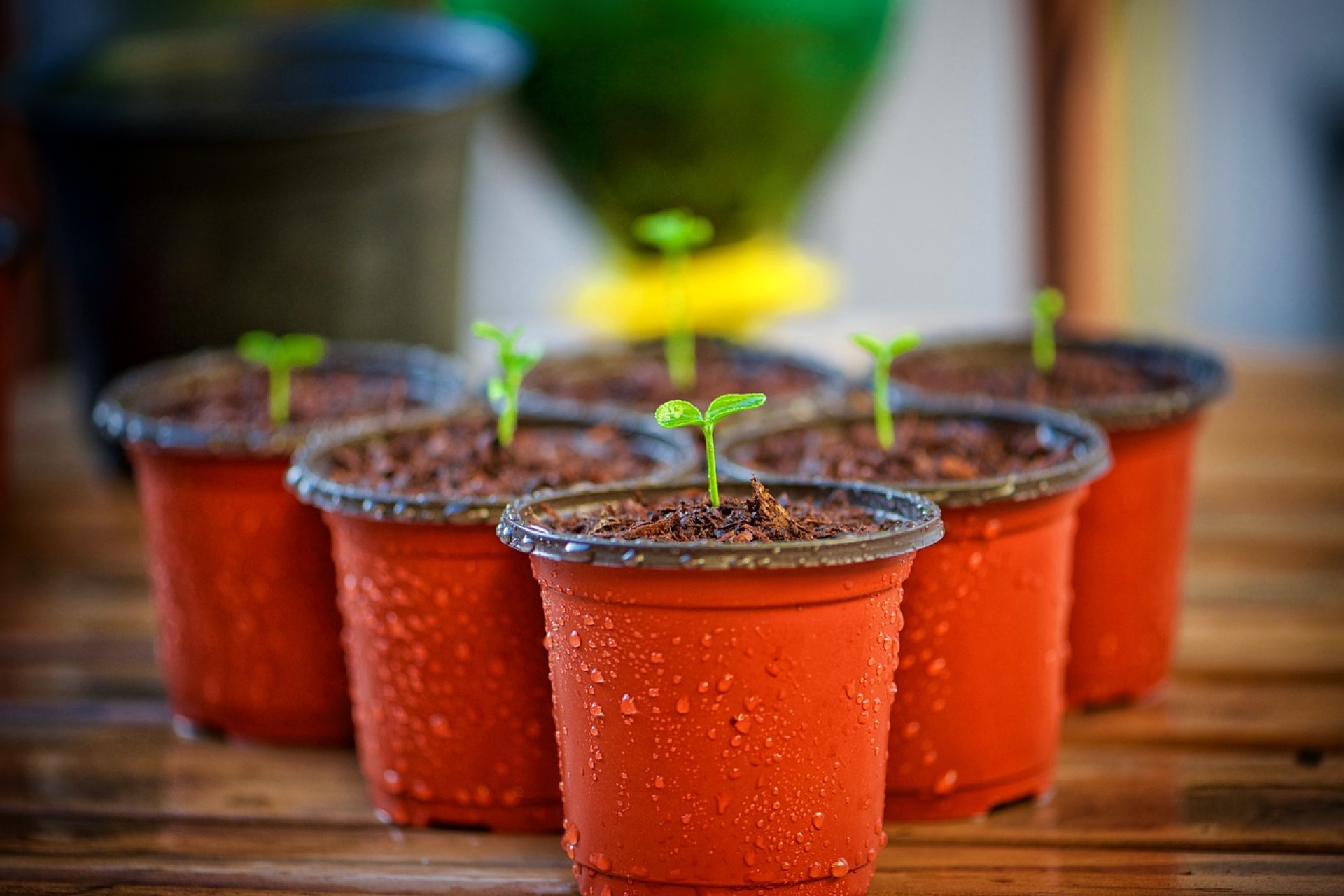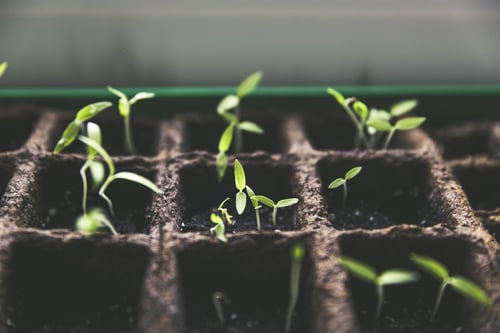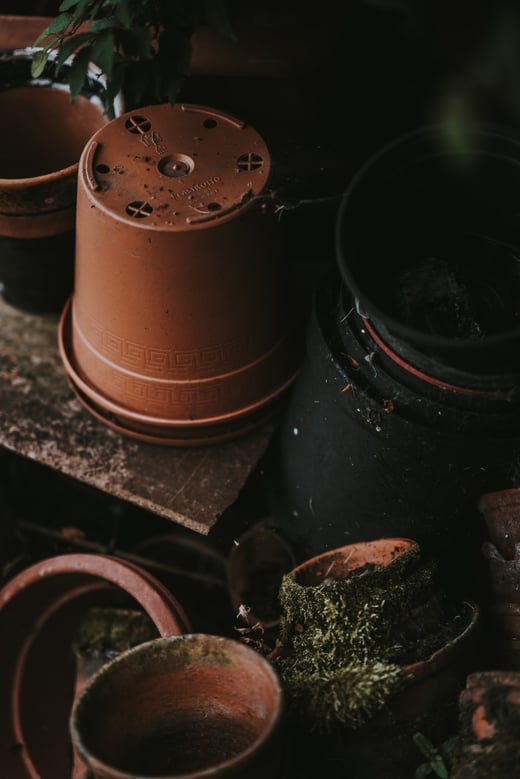
Plastic pots are a major bugbear of the landscaping and green roofing industries, but are biodegradable pots really the answer? Today we explore what works and what doesn’t, as well as what YOU can do about it.
You’ve been there. You buy a new plant, perhaps a tomato for the garden or a dracaena for the windowsill. You grab a terra cotta pot, upend your new baby, give it a new home and …
… you’re left with a plastic pot. What do you do?
Most of us dutifully wash it and stick it in the recycle bin for municipal pickup or dropoff. Problem solved, right?
Umm. Well, no.
Unfortunately, our recycling system today is pretty broken. Municipalities might take plastic pots, and nurseries might promise to recycle them, but – not to put too fine a point on it – that’s mostly B.S. What doesn’t get thrown away can clog up sorting machines at recycling plants, or it gets shipped to developing countries, adding to their mounting problems. Needless to say, outsourcing the issue does not get rid of the issue.
No, the responsibility is on us – the American landscaping and green roofing industry – to lead the advance toward a more sustainable future.
*waves torch*
If we want to act as good stewards of the environment, it’s critical we solve this here plastic problem as soon as possible. And biodegradable pots are, in theory, a good way to do that.
But are they really? If so, what do we need to do in order to shift the industry away from chronic plastic use and toward a more sustainable alternative? Let’s take a look.
What Are Biodegradable Pots?
 We spend a lot of time here at Ecogardens trying to balance green roof health and build healthy green systems. While we like to think we’re pretty successful, we understand how important it is not to prioritize one green solution over another.
We spend a lot of time here at Ecogardens trying to balance green roof health and build healthy green systems. While we like to think we’re pretty successful, we understand how important it is not to prioritize one green solution over another.
No matter how awesome our green roofs are, we don’t want to add to a different environmental problem. That’s like borrowing from Peter to pay Paul.
Which is why biodegradable pots have had our attention for a long time. As their name suggests, these pots work like a normal plastic pot – serving as a temporary home for plants while awaiting purchase and planting – but break down once in the soil.
Translation: no plastic waste, theoretically.
As an additional benefit, biodegradable pots can go straight into the ground, significantly reducing the amount of shock the plant experiences. Many of them also preserve the root structure of plants, allowing roots to grow out of the pot, where they are air pruned, and preventing them from becoming rootbound.
Sounds pretty great, right?
Why Isn’t Everyone Using Them?
As much as we love the idea, though, the execution of biodegradable pots is often problematic.
Perhaps the biggest problem is that everyone is talking about the issue, but there hasn’t been an industry-wide push to solve it. Even the crunchiest landscapers haven’t yet taken on the challenge, which has several prongs:
- A biodegradable pot will start to decompose whether plants get bought or not, so if a nursery doesn’t sell the plants, it has to repot them.
- Repotting plants doubles the labor and therefore labor costs.
- Repotting also requires buying more pots. Obviously.
- Many so-called sustainable alternatives are not sustainable at all, such as peat, which is a non-renewable resource that’s often painted as one.
Consequently, along with fertilization and weed control (also currently unsustainable activities in landscaping), plastic is right up there with one of the most urgent matters that needs to be addressed. Luckily, it is happening.
What Approaches Are Most Promising Today?
 Not many companies solely produce biodegradable pots. One exception is Fertilpot, which is dedicated to creating an impressive line of pots and trays for nursery and home use. As their brochure explains, the pots are made from wood fibers, and they use no glue, binders or synthetic ingredients.
Not many companies solely produce biodegradable pots. One exception is Fertilpot, which is dedicated to creating an impressive line of pots and trays for nursery and home use. As their brochure explains, the pots are made from wood fibers, and they use no glue, binders or synthetic ingredients.
Some companies are making pots from biodegradable plastic, which might sound like an oxymoron, but isn’t. Plastic is an organic compound, after all, though it usually takes much longer than a year or two to biodegrade.
Other pots are made from rice and corn. The most sustainable of these are manufactured from the waste product of the agricultural industry. Paper is another common substance.
What Can You Do to Solve the Plastic Problem?
So what’s your role? Simply this: to find the best alternative in your area and for your needs.
Some nurseries allow you to return pots for reuse. This is the minority, admittedly, due to the challenges of washing and sterilizing, which are required in order to use them again. Or they may send them to a recycler, whom they often have to pay for the privilege (again, there goes money getting in the way). Always ask, though; if you can find a nursery that offers this alternative, that’s awesome.
One of the best bets is to support companies who are actively seeking new solutions. Even if they also purvey plastic pots, by giving them your dollar, you’re voting for their sustainability research and helping make a difference for the future.
Want to talk to us about the issue further? Get in touch.

